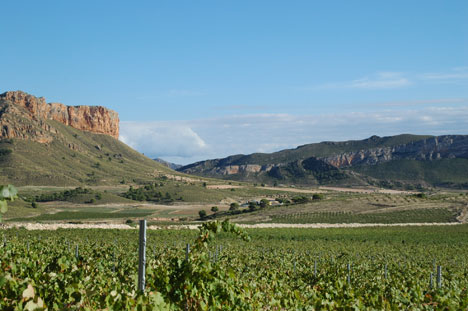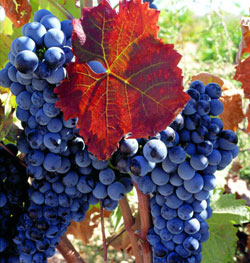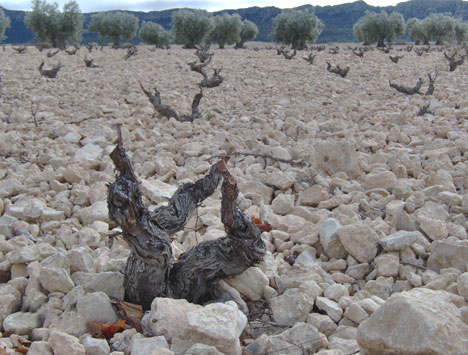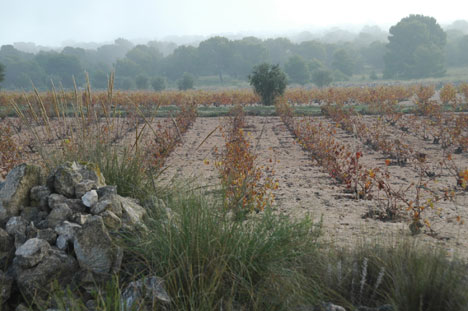The Region of Murcia is located in the south-east of Spain on the Mediterranean coast. Framed by the regions of Valencia, Castilla-La Mancha and Andalucía, it belongs to the Levante and is also a province. Murcia is also the name of the provincial capital.
With about 300 days of sunshine per year, the region is one of the driest areas in Europe. Temperatures climb above 40 degrees in summer and in the mild winters there are at most single-digit sub-zero temperatures. At the same time, however, Murcia is the largest supplier of vegetables, fruit and flowers in Europe, which is not viewed uncritically everywhere because of the considerable water consumption for irrigating the agricultural areas. In addition to agriculture, the construction and furniture industries as well as tourism are important economic sectors. Viticulture is practised on a total area of 47,000 hectares and in three cultivation areas with protected designation of origin(DO), which are named after the towns around which they extend: DO Bullas, DO Jumilla and DO Yecla.
 |
| (Photo: CRDO Jumilla) |
The town of Bullas was founded by the Romans and is located about 50 kilometres from the provincial capital of Murcia, on a plateau near the river Mula. The climate is Mediterranean with an average rainfall of 450 millimetres. Wine, almonds, peaches and olives are grown in and around Bullas. Wine growing also dates back to Roman times, and in the historic town centre there are more than 200 fully or partially preserved wine cellars, most of which were built in the 18th and 19th centuries. The DO Bullas has existed since 1994 and comprises about 2,300 hectares of vineyards, which are located at an average altitude of 500 to 800 metres above sea level.
Monastrell is the main grape variety in the region, accounting for over 90 percent, while Tempranillo, Cabernet Sauvignon, Garnacha, Syrah, Merlot and Petit Verdot are also grown as red varieties. Surprisingly, however, red wines only account for one third of the production here, with Rosados accounting for almost two thirds. The white wines, which are only produced in very small quantities, are mainly made from Macabeo and Airén as well as Chardonnay, Malvasía, Sauvignon Blanc and various Moscatel varieties. Due to the different soil and microclimate conditions, the DO Bullas offers a great variety of wines. New cellar techniques bring out the advantages of the Monastrell grape in particular, and due to the very high altitude of the vineyards, it is not uncommon for rather cool, fruity and balanced wines to be produced.
Bodegas del Rosario, Bullas
The Bodegas del Rosario cooperative is the largest wine producer in the Bullas DO. 95 per cent of the wines exported from the area come from this joint venture. It was founded in 1950 when some winegrowers in Bullas joined forces to build a new, better-equipped winery. Today, the cooperative has three wineries and practices sustainable viticulture. Monastrell is planted on 85 percent of the vineyards, and Tempranillo, Syrah, Cabernet Sauvignon, Macabeo and Airén are also cultivated. This produces wines for five lines: Las Reñas, Lorca, Ucenda, Señorío de Bullas and Tesoro de Bullas.
Bodegas Begastri, Cehegín
 |
| (Photo: CRDO Jumilla) |
Bodegas Begastri is located in the municipality of Cañada de Canara, which belongs to the town of Cehegín. The name Begastri goes back to the Roman foundation "Begastrum" - there is evidence of viticulture in the area of Cehegín as early as the first century AD. The vineyards of Begastri lie at an altitude of 600 to 1,000 metres in a south-westerly orientation. Hot, dry summers, rain in spring and autumn and cold winters determine the climate. The soils are characterised by limestone and are predominantly planted with Monastrell; Syrah, Cabernet Sauvignon, Merlot and Garnacha are also grown. Begastri's winery extends over three storeys and was driven deep into the rock. 15 metres below ground, the wines ripen on an area of 350 square metres under completely constant environmental conditions. The top red wine "Sinedie" is produced organically.
Bodega Tercia de Ulea, Moratalla
Tercia de Ulea cultivates 45 hectares of vines in four sites in the municipality of Moratalla: Ulea, Los Charcos, El Portugués and La Alberquilla. The vineyards are located at an altitude of 670 to 820 metres on limestone and clay soils, where the grapes receive over 2,900 hours of sunshine per year in a Mediterranean climate. In August, the temperature in this area is over 25 degrees day and night. The grapes ripen slowly and the harvest takes place at the beginning of October. Rich, full-bodied red wines are made from Monastrell and, to a lesser extent, Tempranillo, Cabernet Sauvignon and Syrah. The range also includes dry and semi-dry Rosados. The racking of the winery into the neighbouring "Casa de Labor" has once again improved the production conditions.
Bodega Balcona, Bullas
Bodega Balcona is surrounded by vineyards in the Aceniche valley, which is known for the beauty of its landscape and its high ecological value. The soil structure and microclimate in this valley are diverse; a few metres can determine whether or not the vines are exposed to frost in winter. Balcona's Monastrell vines grow on black shale, the Tempranillo is on chalky soil; Cabernet Sauvignon has clay and gravel as its base, Syrah is on limestone, and Merlot grows on limestone and clay. The vineyards reach up to 900 metres above sea level. Grapes from 60-year-old Monastrell vines are used for the top wine "Partal".
Bodega Los CeperosLa Alberca
In a valley at the foot of the Sierra de la Lavia, near Cehegín, is the Bodega Los Ceperos, founded in 1996. The winery cultivates 20 hectares, 60 percent of which are planted with Monastrell; the remaining area is shared by Cabernet Sauvignon and Merlot vines. On the hills surrounding the valley, the vineyards are situated at an average altitude of 800 metres on clay and calcareous soils with alluvial rocks. The continental climate with Mediterranean influence gives the grapes more than 2,000 hours of sunshine per year and strong temperature differences between day and night. Los Ceperos practices organic viticulture and has set up a modern winery where the wines mature in an underground sandstone vault.
Bodegas Lavia / Molino y Lagares de Bullas, Bullas
Molino y Lagares was founded in 2004 by a group of wine lovers who were convinced of the potential of the DO Bullas. The winery is located in the Venta del Pino and cultivates several areas at an altitude of more than 800 metres: one with Monastrell vines up to 30 years old, one with Monastrell vines up to 40 years old and another small area with Syrah. The soils consist of clay, limestone, gravel and pebbles. Molino y Lagares follows the idea of terroir and practices natural viticulture.
 |
| (Photo: CRDO Jumilla) |
With 41,300 hectares of vineyards, the DO Jumilla is one of the largest in Spain. It is also one of the oldest, having been granted DO status as early as 1966. Viticulture in this area can be traced back over 5,000 years. For example, the oldest remains of a vine plant(Vitis vinifera) in the whole of Europe have been found in Jumilla, dating back to around 3000 BC. The landscape between the Mediterranean coast and the Castilian highlands is characterised by wide valleys and plains surrounded by mountains. Besides Jumilla itself, wine-growing municipalities are Montealegre del Castillo, Fuenteálamo, Ontur, Hellín, Albatana and Tobarra. The vineyards are located between 400 and 800 metres above sea level.
Jumilla has a continental climate with summer temperatures of often 40 degrees, long dry periods and a low annual rainfall of 300 millimetres. The soils contain lime, iron oxide, sand and clay, while their salinity is low. Water can drain away well and is stored in deeper layers. These climatic and soil conditions favour the cultivation of Monastrell, which is actually found on over 80 percent of the vineyard area of the DO Jumilla. Other red grape varieties cultivated are Garnacha, Cencibel (Tempranillo), Tintorera, Cabernet Sauvignon, Merlot, Syrah and Petit Verdot; the red varieties together account for 96 percent of the vineyard area. The white wines are made from Airén, Macabeo and Merseguera, and in small quantities from Malvasía, Chardonnay, Sauvignon Blanc and Moscatel. Traditionally, naturally sweet wines are also made from overripe Pedro Ximénez or Monastrell grapes.
In the past, mostly alcohol-heavy, simple wines were produced in the DO Jumilla. They were mostly sold in barrels and served other regions to add more colour and alcohol to their own wines. Even today, some particularly dark, full-bodied and tannic red wines are made using the doble pasta technique. After Jumilla had been spared from phylloxera in the 19th century due to the special soil structure, it afflicted the area at the end of the 1980s. For the new plantings that became necessary as a result, the winegrowers used better grape varieties and raised the quality standard for production significantly. Even today, the red wines of Jumilla are usually very powerful and high in alcohol, but they now often have significantly more polish and are at the same time finer, purer and more expressive than before.
Propiedad Viticola Casa de CastilloJumilla
Frenchmen built a winery on the Casa Castillo estate as early as 1870. In 1985, Nemesio Vicente and his son José María, who now runs the estate, resumed the winegrowing tradition. Casa Castillo is located on the high plateau of Jumilla, where the climate is continental with Mediterranean influences. On the 174 hectares of vineyards that the winery cultivates, Monastrell, Garnacha, Syrah and Cabernet Sauvignon are predominantly grown on clayey soil.
Bodegas Olivares, Jumilla
The family winery Bodegas Olivares was founded in 1930 and covers more than 200 hectares of vineyards. The vineyards are situated at an altitude of 650 to over 800 metres with a northeastern exposure. Monastrell, Syrah and Tempranillo are cultivated. The strong temperature differences between day and night as well as the long vegetation period allow complex aromas to develop in the grapes, and the wines present themselves surprisingly fresh and elegant. Oenologist Paco Selva produces, among other things, a Monastrell sweet wine.
Bodegas Hacienda del Carche, Jumilla
Bodegas Hacienda del Carche cultivates 60 hectares of vines, some of which are ungrafted. The winery, with its modern equipment, has been in existence since 2006, although the wine-growing tradition of the owner's family goes back as far as the 19th century. Some of the vineyards are more than 50 years old. The red wines are made from Monastrell, Tempranillo, Syrah, Cabernet Sauvignon and Garnacha, the white wines from Macabeo and Sauvignon Blanc.
 |
| (Photo: CRDO Jumilla) |
The DO area of Yecla consists of only one municipality. To the west, the DO borders Jumilla, to the north Almansa (Region of Castilla-La Mancha) and to the east Alicante (Region of Valencia). The vineyards, which a few years ago covered around 20,000 hectares, are located on a plateau between 400 and 800 metres above sea level and are surrounded by hills. Today, 11,500 hectares are still used for viticulture, of which only 4,600 are approved for quality wine. These areas have had DO status since 1975.
Deep lime and clay soils on limestone or clay ensure good water permeability and water storage capacity in the subsoil. The DO Yecla has a continental climate with dry, hot summers and moderate winters. The amount of precipitation is very low at around 300 millimetres per year, but the average sunshine duration per year is a full 3,000 hours. Storms can occur frequently in spring and autumn.
More than 90 percent of the grapes grown in Yecla are red, especially Monastrell, which accounts for 85 percent of the vineyard area, followed by Garnacha, Cabernet Sauvignon, Cencibel (Tempranillo), Merlot, Tintorera and Syrah. The most important white varieties are Merseguera, Airén, Macabeo, Malvasia and Chardonnay. Yecla was largely spared from phylloxera, so that a large part of the vineyards are still planted with autochthonous vines ungrafted.
The growing area is divided into two sub-zones: On the higher vineyards of the Yecla Campo Arriba, mainly the Monastrell grape variety is cultivated, from which rich and mostly alcoholic red wines are made. The vineyards of Yecla Campo Abajo are lower and also produce wines with alcohol levels between 11.5 and 12 percent by volume. Like Jumilla, Yecla's wines contributed significantly to the region's export volume for many years. This changed for the time being when the sales markets raised their quality standards. Today, many wineries in the DO Yecla have been refurbished and produce wines in a lighter style that are once again absolutely competitive outside the region.
Bodegas Castaño, Yecla
Ramón Castaño Santa founded the winery in 1950, following in the footsteps of his ancestors. From the mid-1970s, he expanded the vineyards to around 500 hectares today, which are divided into four large vineyards in the DO Yecla: Las Gruesas, El Espinal, Pozuela and Arabí. The soils consist of varying proportions of limestone, clay and sand. Castaño's sons Ramón, Juan Pedro and Daniel began expanding distribution to international markets in the early 1990s. The bodega produces mostly Monastrell, but also has Tempranillo, Garnacha, Cabernet Sauvignon, Cabernet Franc, Merlot, Syrah and Tintorera as well as Chardonnay, Sauvignon Blanc and Macabeo in its inventory. Castaño works partly organically and according to the guidelines of integrated agriculture. In addition, the winery is certified according to the ISO 9001 quality assurance system and the ISO 14001 environmental management system.
Señorio de Barahonda, Yecla
Señorio de Barahonda is owned by the Candela family, who founded their first winery in 1925. Surrounded by vineyards, Señorio de Barahonda is located in the hilly north-east of the Murcia region. The vineyard area comprises 150 hectares owned by the estate and a further 350 hectares cultivated under contract. Besides the main grape variety Monastrell, Tempranillo, Merlot, Syrah, Cabernet Sauvignon and Petit Verdot are also cultivated. Macabeo and Airén are grown as white varieties. The vines of Señorio de Barahonda grow at an altitude of 600 to 800 metres on calcareous soils.
The currently tasted wines of the three Murcia-DOs in the wine guide